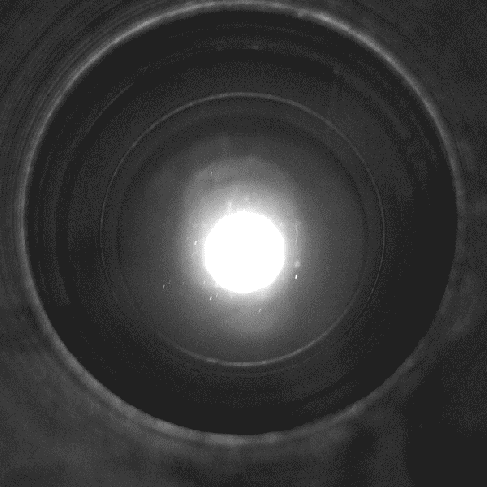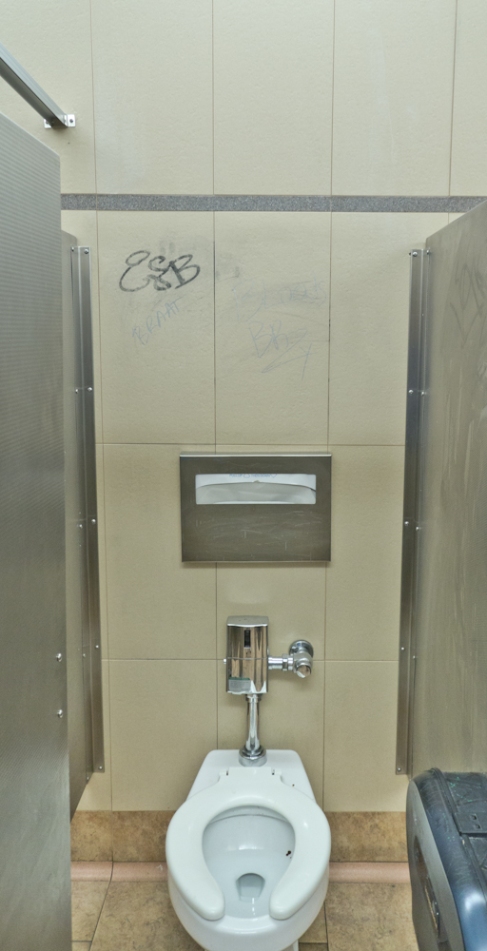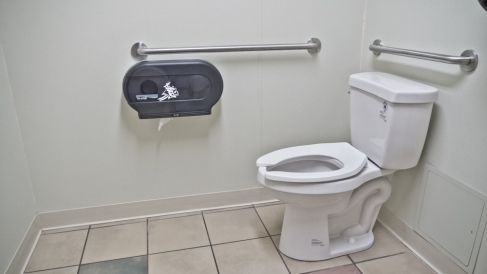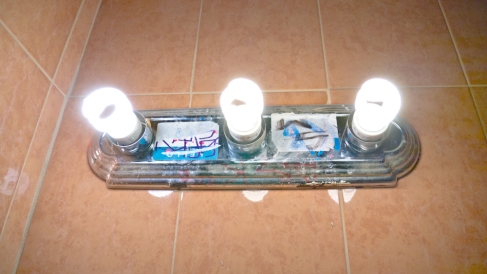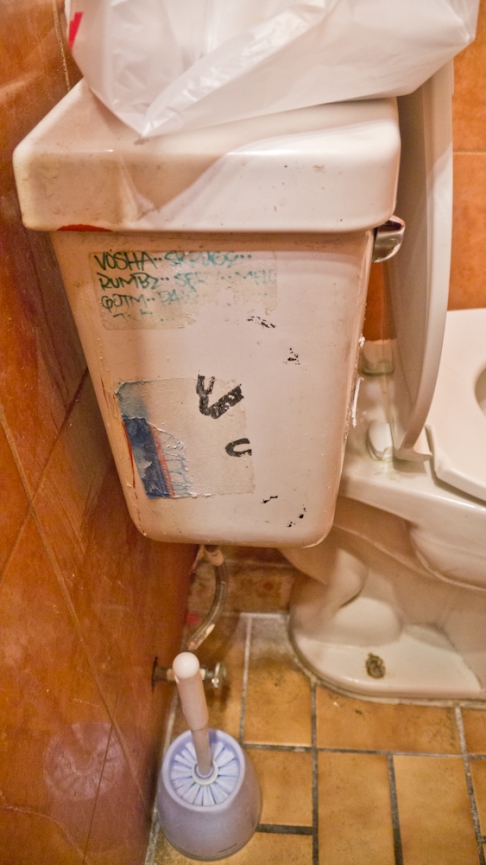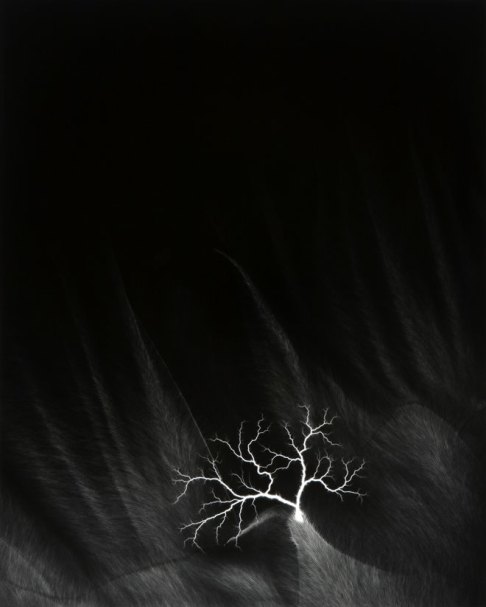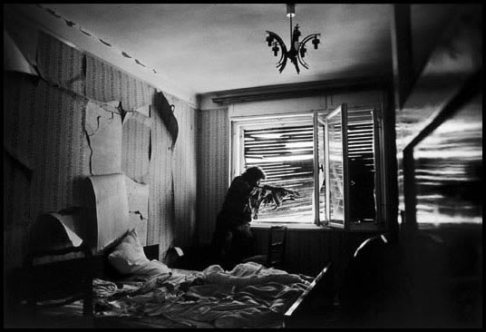Erik Refner

Erik Refner was born January 14th, 1971 in Copenhagen and was raised north of the city. In his teen years, he traveled the world and ended up in Kibbutz for 3 months in Israel. Upon his return, he became a sergeant in the Danish army. He began working heavily in photography and in 2001 won the World Press Photo of the Year with the image pictured below. The picture above, however, is part of a series he did about rockabilly culture. The photo above has so much texture. The crushed blacks and precisely tuned highlights give the image a graphic novel quality that pops beyond belief. The photo is composed somewhat “front heavy”, giving the image a heavy and dense feeling. The subject is covered in some type of fluid (probably water) and grime which also adds greatly to the texture of the image. All of his images have this very dense, textured, and graphic quality which is exemplified here.

Photo A Day
“Advertising is one of the strongest forces in the “urban sprawl” movement today. One can hardly drive, walk, or shop anywhere without being bombarded by heavily retouched photos of some stock image model. There a very few public places remaining that have yet to be coated with these advertisement, one being the public bathroom. For the most part, this remains a blank and very private place and to some apparently, a blank canvas. From artist type to gang bangers, the walls and appliances within have become a place for personal statements, group symbols, and crude language. Within this series, I explore this very private art through the scope of photography. I take a very expository approach to the composition of these photographs. I am not trying to spin this art in any way; merely to showcase it. This eye on this subliminal and, to some, defacing art exposes the beauty of this venue. The walls provide a space for any thought of the “artists” to be splashed onto the wall, clashing with others’ and combining into a hybridized piece. Such sterile and and bleak places as public bathrooms clash with the colorful and chaotic art of people from very different ends of the spectrum, coming together into a ragged hodge-podge that very much mirrors the urban ideology of today.”
“Graffiti”
Every art form I’ve ever dabbled in has been widely accepted for the most part. Only recently had I gained interest in graffiti. For me, it had always been a welcome sight on rather drab and desolate urban settings but for some it has always been a nuisance. Graffiti artists have been barred from the streets and interpreted as hoodlums and criminals. In this series, I examine the repercussions of this preconception; how an artist copes with his medium being barred and taken away from him. With only a single lens and simple flash, I portray an artist whose medium has been stolen. Within these confines, creativity and artistic expression takes on a different meaning entirely. From wall to canvas, the style is consistent.
Hiroshi Sugimoto at UNM’s Art Museum
The visit to the Art Museum here at UNM seemed rather routine until one of the women showing us the exhibition mentioned that there was a Sugimoto exhibition just up the stairs. I immediately followed her as she led a small group up the stairs. She flipped on the lights and voila, eight Sugimoto pieces. One of the most striking which I hadn’t seen before is pictured above. As always, Sugimoto’s concepts are incredibly solid, simple, and elegant. From Wired magazine:
“He wields a Van de Graaff generator to send up to 400,000 volts through film to a metal table. The resulting fractal branching, subtle feathering, and furry whorls call to mind vascular systems, geologic features, and trees. “I see the spark of life itself, the lightning that struck the primordial ooze,” Sugimoto says. Although some of the effects happen by chance, the artist does try to exercise control. “I have a kitchen’s worth of utensils that produce sparks with different characteristics,” he says. “But there are many variables — weather, humidity, perhaps even what I had for breakfast — I’m never sure what influences the results.””
It’s such a unique process that creates so much depth and texture. It’s abstract enough to allow the imagination to flourish but contains enough content to allow the audience to attempt to ground it in reality. This hybrid of surrealism and traditional art creates a very unique in-between that engages the viewer beyond anything I’ve ever seen.
Richard Billingham, “Ray’s A Laugh” No. 7, 1995

Richard Billingham’s “Ray’s A Laugh” is a photo book published in 2000 by Scalo. It depicts his alcoholic father and overweight, smoker mother. Billingham takes a very visceral and intimate approach to this display of his family.
Some very telling words from Billingham himself:
“My father Raymond is a chronic alcoholic.
He doesn’t like going outside, my mother Elizabeth hardly drinks,
but she does smoke a lot.
She likes pets and things that are decorative.
They married in 1970 and I was born soon after.
My younger brother Jason was taken into care when he was 11,
but now he is back with Ray and Liz again.
Recently he became a father.
Dad was some kind of mechanic, but he’s always been an
alcoholic. It has just got worse over the years.
He gets drunk on cheap cider at the off license.
He drinks a lot at nights now and gets up late.
Originally, our family lived in a terraced house,
but they blew all the redundancy money and, in desperation,
sold the house. Then we moved to the council tower block,
where Ray just sits in and drinks.
That’s the thing about my dad, there’s no subject he’s interested
in, except drink.”
“It’s not my intention to shock, to offend, sensationalise,
be political or whatever, only to make work that is as spiritually
meaningful as I can make it –
in all these photographs I never bothered with things like
the negatives. Some of them got marked and scratched.
I just used the cheapest film and took them to be processed
at the cheapest place. I was just trying to make order out of chaos.”
His talk of using the cheapest film and getting the images processed in the cheapest place is what really struck me when I first viewed these images. The whole series, especially this photo in particular, have a very rough and “found” feel to them. Shooting on a small camera really gave Billingham the opportunity to take a very voyeuristic approach. This particular photo, he manages to capture somewhat of a “decisive moment”. The awkward positioning and lack of ground of the subject implies that he is falling over. As we can gather from the series, it is from Billingham’s father’s drunkenness. The timing of this photo, the medium it was captured on, as well as the manner in which it was processed all lend themselves to the harsh intimacy of this entire collection.
James Nachtwey, Bosnia, 1993 – Ethnic cleansing in Mostar. Croat militiaman fires on his Moslem neighbors.
James Nachtwey is an American photographer born in 1948 in Syracuse, New York. His first step into photography was actually right here in Albuquerque, working as a newspaper photographer for the Albuquerque Journal in 1976. A short 5 years later, he had moved on to freelance photography in New York and was in Northern Ireland, covering his first overseas assignment. He has covered many overseas conflicts in South Africa, the Middle East, Russia, Latin America, the former Soviet Union, Western Europe, the United States and, where this picture was taken, Eastern Europe. More specifically this photo was taken in Bosnia in 1993 during the Bosnian War. During this war, ethnic cleansing was widespread against the Bosniaks (a group of southern Slavs). In this photo, you can see a Croat militant firing from his window upon them (or so the caption states).
What really drew me to this photo was the setting. At first glance, it looks simply like a disheveled bedroom. Upon closer examination, one can see the man is not simply looking out his window, but firing out of it with an automatic weapon. This instantly transforms such a benign setting into a sinister landscape. The huge amount of dynamic range captured here lends so much texture to the decrepit room. The voyeuristic perspective in this photo is immense. I believe it’s due to the fact that we can see the slightly opened door in the frame and there is zero acknowledgement from the subject that Nachtwey was there. From this, I would assume this was shot on 35mm, probably on midspeed film, something like 400. There is just enough grain to give it texture without overbearing the image. The subject is semi centered, set a little to the left of center. This gives the subject a little extra “looking room” implying that there is something he is aiming at, even though we can’t see them in the frame. The most powerful thing about this image is really the setting. The war is quite literally brought home. Traditionally, we see images of war in some destroyed city block, a desert field, or jungle. Here, the gun is brought right into the bedroom, which for me, is greatly disturbing on a very different level than most war photographs. Nachtwey, across his work, seems to have a knack for bringing violence and destruction home.
Mary Ellen Mark, Ward 81, Oregon State Hospital,Salem, Oregon, 1976

Mary Ellen Mark is an American born photographer hailing from Philadelphia. She started her venture into photography at the young age of nine using a Kodak Brownie camera. She continued through school up to shooting production still for Hollywood films. The particular piece I chose was from her “Ward 81” series which was directly linked to her work in the film industry:
“In 1975, photographer Mary Ellen Mark was assigned by a magazine to do a story on the making of One Flew Over the Cuckoo’s Nest, shot on location at the Oregon State Hospital, a mental institution. While there, she met, briefly, the women of Ward 81.
Ward 81 is the women’s security ward of the hospital, the only locked ward for women in the state. The women on this ward are considered dangerous to themselves or to others.
In February of 1976, Mary Ellen and Karen Folger Jacobs, a writer and social scientist, were given permission to live on the ward in order to photograph and interview the women. They spent thirty-six days on Ward 81.”
The entire collection is quite offsetting. It’s common knowledge that the condition of mental institution isn’t the best. In this series, we see a variety of characters juxtaposed against the bleak walls of Oregon State Hospital. This photo stood out. Mark shoots on a variety of formats but prefers a 35mm Nikon, which I’m guessing this was shot on. This image was captured in a very voyeuristic and snap shot-esque manner which I don’t think would be achievable by anything larger. The exposure being in black and white gives it a very graphic quality. The cluster of hands and body parts exudes a very chaotic mood as I assume was taking place at the time. The angle the photo was taken from positions the woman being held down in a very certain space in the frame that implies her upward motion against the hands coming down against her. I think that all of these things work together to tell a story of entrapment, not only within an institution but within the mind of these patients as well.
Hiroshi Sugimoto, “Tri City Drive-In”, 1993

Hiroshi Sugimoto is a Japanese born but American taught photographer. He uses a large format 8×10 camera and is known for his expertise utilizing it. In 1978, shortly after finishing his education, Sugimoto started a series of pictures portraying movie theater screens that are illuminated solely in white. He set up his large format camera, opened the shutter at the beginning of the movie, and closed it at the end. The result was a somewhat hauntingly empty image of a normally populated space only being illuminated by the screen. On his website he states:
“I’m a habitual self-interlocutor. Around the time I started photographing at the Natural
History Museum, one evening I had a near-hallucinatory vision. The question-and-
answer session that led up to this vision went something like this: Suppose you shoot a
whole movie in a single frame? And the answer: You get a shining screen. Immediately I
sprang into action, experimenting toward realizing this vision. Dressed up as a tourist, I
walked into a cheap cinema in the East Village with a large-format camera. As soon as
the movie started, I fixed the shutter at a wide-open aperture, and two hours later when
the movie finished, I clicked the shutter closed. That evening, I developed the film, and
the vision exploded behind my eyes.”
The above picture is the continuation of the the theater series almost twenty years later. I like this one the most out of all of his photographs. The setting of this photo being outdoors at a drive thru really sets a unique mood and captures a very specific point in history. Drive thru’s being almost completely gone and replaced by huge multiplexes sets this photo back in time. To me, it’s reminiscent of a more “wholesome” time in history. The drive thru brings images of 1950s and 60s large cars filled with families and teenage friends. In the foreground of this photo is another unfortunately abandoned landmark: the playground. This again is attached to this idea of the “wholesome” nuclear family. In today’s society, children are sucked into a mass media frenzy indoors. Then, children were regularly playing outdoors. The combination of the empty playground, illuminated by a blank movie screen says something very powerful about media and how it’s changed society. A whole other tier of content can be seen behind the screen. The slight foliage seems to hint at an unkempt area being forgotten by time. The trails from the airplanes of the background speaks to the same issue of technology always distracting. Even though the focus is the film, the world continues to revolve and move, never taking break.
